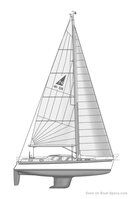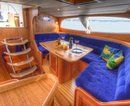Nordship 40 DS
Sailboat specifications
The Nordship 40 DS is a 40’ (12.2m) cruising sailboat designed by Lars Buchwald (Denmark) and Borghegn Yachtdesign (Denmark). She is built since 2005 by Nordship Yachts (Denmark).
Nordship 40 DS's main features
- Model
- Nordship 40 DS
- Hull type
- Monohull
- Category
- Deck saloon cruising sailboat
- Sailboat builder
- Sailboat designer
- Country
- Denmark
- Construction
- GRP (glass reinforced polyester):
Sandwich fiberglass polyester with galvanized steel frame - First built hull
- 2005
- Last built hull
- Still in production
- Appendages
- Keel : L-shaped keel (with bulb)
- Helm
- Single helm wheel
- Rudder
- Single spade rudder
- Unsinkable
- No
- Trailerable
- No
- EC design categoryiThe CE design category indicates the ability to cope with certain weather conditions (the sailboat is designed for these conditions)
A: Wind < force 9, Waves < 10m
B: Wind < force 8, Waves < 8m
C: Wind < force 6, Waves < 4m
D: Wind < force 4, Waves < 0,5m - A
- Standard public price ex. VAT (indicative only)
- About426 000 €(2020)
Nordship 40 DS's main dimensions
- Overall length
- 42’ 4”12.9 m
- Hull length
- 40’12.2 m
- Waterline length
- 35’ 5”10.8 m
- Beam (width)
- 13’ 6”4.1 m
- Draft
- 5’ 11”1.8 m
- Light displacement (MLC)
- 23149 lb10500 kg
- Ballast weight
- 8378 lb3800 kg
- Ballast type
- Lead
Nordship 40 DS's rig and sails
- Upwind sail area
- 939 ft²87.2 m²
- Mainsail area
- 532 ft²49.4 m²
- Jib area
- 407 ft²37.8 m²
- Rigging type
- Sloop Marconi 19/20
- Mast configuration
- Deck stepped mast
- Rotating spars
- No
- Number of levels of spreaders
- 2
- Spreaders angle
- Swept-back
- Spars construction
- Aluminum spars
- Standing rigging
- Discontinuous
Nordship 40 DS's performances
- Upwind sail area to displacementiThe ratio sail area to displacement is obtained by dividing the sail area by the boat's displaced volume to the power two-thirds.
The ratio sail area to displacement can be used to compare the relative sail plan of different sailboats no matter what their size.
Upwind: under 18 the ratio indicates a cruise oriented sailboat with limited performances especially in light wind, while over 25 it indicates a fast sailboat. - 196 ft²/T18.19 m²/T
- Displacement-length ratio (DLR)iThe Displacement Length Ratio (DLR) is a figure that points out the boat's weight compared to its waterline length. The DLR is obtained by dividing the boat's displacement in tons by the cube of one one-hundredth of the waterline length (in feet).
The DLR can be used to compare the relative mass of different sailboats no matter what their length:
a DLR less than 180 is indicative of a really light sailboat (race boat made for planning), while a DLR greater than 300 is indicative of a heavy cruising sailboat. - 236
- Ballast ratioiThe Ballast ratio is an indicator of stability; it is obtained by dividing the boat's displacement by the mass of the ballast. Since the stability depends also of the hull shapes and the position of the center of gravity, only the boats with similar ballast arrangements and hull shapes should be compared.
The higher the ballast ratio is, the greater is the stability. - 36 %
- Critical hull speediAs a ship moves in the water, it creates standing waves that oppose its movement. This effect increases dramatically the resistance when the boat reaches a speed-length ratio (speed-length ratio is the ratio between the speed in knots and the square root of the waterline length in feet) of about 1.2 (corresponding to a Froude Number of 0.35) . This very sharp rise in resistance, between speed-length ratio of 1.2 to 1.5, is insurmountable for heavy sailboats and so becomes an apparent barrier. This leads to the concept of "hull speed".
The hull speed is obtained by multiplying the square root of the waterline length (in feet) by 1.34. - 7.98 knots
Nordship 40 DS's auxiliary engine
- Engine(s)
- 1 inboard engine
- Engine(s) power
- 55 HP
- Fuel type
- Diesel
- Fuel tank capacity
- 100.4 gal380 liters
Nordship 40 DS's accommodations and layout
- Cockpit
- Center cockpit
- Cabin(s) (min./max.)
- 2 / 3
- Berth(s) (min./max.)
- 4 / 7
- Head(s)
- 2
- Freshwater tank capacity
- 132.1 gal500 liters
- Holding tank capacity
- 23.8 gal90 liters
- Fridge/ice-box capacity
- 29.1 gal110 liters


Nordship Yachts Nordship 40 DS - - 1/15
Picture extracted from the commercial documentation © Nordship Yachts
Picture extracted from the commercial documentation © Nordship Yachts


Nordship Yachts Nordship 40 DS sailplan - - 2/15
Picture extracted from the commercial documentation © Nordship Yachts
Picture extracted from the commercial documentation © Nordship Yachts


Nordship Yachts Nordship 40 DS layout - - 3/15
Picture extracted from the commercial documentation © Nordship Yachts
Picture extracted from the commercial documentation © Nordship Yachts


Nordship Yachts Nordship 40 DS sailing - - 4/15
Picture extracted from the commercial documentation © Nordship Yachts
Picture extracted from the commercial documentation © Nordship Yachts


Nordship Yachts Nordship 40 DS sailing - - 5/15
Picture extracted from the commercial documentation © Nordship Yachts
Picture extracted from the commercial documentation © Nordship Yachts


Nordship Yachts Nordship 40 DS sailing - - 6/15
Picture extracted from the commercial documentation © Nordship Yachts
Picture extracted from the commercial documentation © Nordship Yachts


Nordship Yachts Nordship 40 DS sailing - - 7/15
Picture extracted from the commercial documentation © Nordship Yachts
Picture extracted from the commercial documentation © Nordship Yachts


Nordship Yachts Nordship 40 DS cockpit - - 8/15
Picture extracted from the commercial documentation © Nordship Yachts
Picture extracted from the commercial documentation © Nordship Yachts


Nordship Yachts Nordship 40 DS interior and accommodations - - 9/15
Picture extracted from the commercial documentation © Nordship Yachts
Picture extracted from the commercial documentation © Nordship Yachts


Nordship Yachts Nordship 40 DS interior and accommodations - - 10/15
Picture extracted from the commercial documentation © Nordship Yachts
Picture extracted from the commercial documentation © Nordship Yachts


Nordship Yachts Nordship 40 DS interior and accommodations - - 11/15
Picture extracted from the commercial documentation © Nordship Yachts
Picture extracted from the commercial documentation © Nordship Yachts


Nordship Yachts Nordship 40 DS interior and accommodations - - 12/15
Picture extracted from the commercial documentation © Nordship Yachts
Picture extracted from the commercial documentation © Nordship Yachts


Nordship Yachts Nordship 40 DS interior and accommodations - - 13/15
Picture extracted from the commercial documentation © Nordship Yachts
Picture extracted from the commercial documentation © Nordship Yachts


Nordship Yachts Nordship 40 DS interior and accommodations - - 14/15
Picture extracted from the commercial documentation © Nordship Yachts
Picture extracted from the commercial documentation © Nordship Yachts


Nordship Yachts Nordship 40 DS interior and accommodations - - 15/15
Picture extracted from the commercial documentation © Nordship Yachts
Picture extracted from the commercial documentation © Nordship Yachts
Similar sailboats that may interest you:
Sailboats
First built hull
Hull length
2002
40’ 8”12.4 m
2012
41’ 5”12.61 m
2007
44’ 6”13.57 m
1978
45’ 4”13.8 m
1988
52’ 6”16 m
1991
40’ 1”12.22 m
2016
39’ 4”11.98 m
2015
40’ 8”12.4 m
2007
38’ 1”11.6 m
2011
43’ 6”13.25 m
2000
52’ 6”16 m
2017
50’ 11”15.51 m
2017
39’ 4”11.99 m
1994
37’ 1”11.31 m
1995
39’ 4”11.98 m